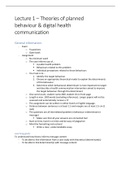Lecture 1 – Theories of planned
behaviour & digital health
communication
General information:
- Exam
o 9 questions
o Open book
- Assignment
o No minimum word
o The case informs you of...
§ A public health problem
§ Behaviours related to this problem
§ Individual perceptions related to those behaviours
o Your task is to...
1. Identify the target behaviour
2. Choose an appropriate theoretical model to explain the determinants
of this behaviour
3. Determine which behavioural determinant is most important to target
and describe a health communication intervention aimed to improve
the target behaviour through this determinant
o Give word count, student-name AND student-ID on front page
o Length is max. 1500 words (excluding references). Longer papers will not be
assessed and automatically receive a ‘0’
o The assignment can be written in either Dutch or English language.
o Distance between sentences is at least 1.5 and margins are at least 2.5 cm (1
inch)
o The questions are all interrelated (problem à behaviour à determinant à
message)
§ Make sure that all your answers are connected too!
o Start on time, hand in on time and be wary of plagiarism
o Mind the formatting instructions!
§ Write a clear, understandable essay
Learning goals:
To understand how theory informs message content
- To be able to link information from a case study with theoretical determinant(s)
- To be able to link determinant(s) with message content
,Theories of planned behaviour
“Nothing is as practical as a good theory” (Kurt Lewin, psychologist)
Why?
- Many behavioural determinants are already known
• At the individual level: e.g., knowledge, attitude, subjective norms, self-
efficacy, intention, etc.
• At the environmental level: e.g., services, funding, policy, etc.
- No need to re-invent the wheel!
Why useful?
- Theory can:
o Help identify reasons WHY people do (not) take health-promoting actions
o Explain behavior and suggest HOW achieve behavior change
o Help pinpoint WHAT you need to know before developing or organizing an
intervention program
o Provide insight into HOW you can shape effective programs
o Identify WHAT should be monitored, measured, and/or compared in program
evaluation
Different kinds of theories
Theories for...
1. Intervention planning (e.g., Intervention Mapping)
2. Explaining and/or predicting behavior (e.g., TRA, TPB, I- Change model)
3. Diffusion of interventions (e.g., Diffusion of Innovations)
The Theory of Reasoned Action
, The Theory of Planned Behaviour
I change model
- Ability factors: are more objective (having no legs)
o Some overlap with predisposing factors and may influence motivation factors
- Motivation factors: are more subjective (the beliefs)
Comprehensive, thus:
- Rather complete, but also...
- ... rather complex!
Make an informed choice for the model you want to use




